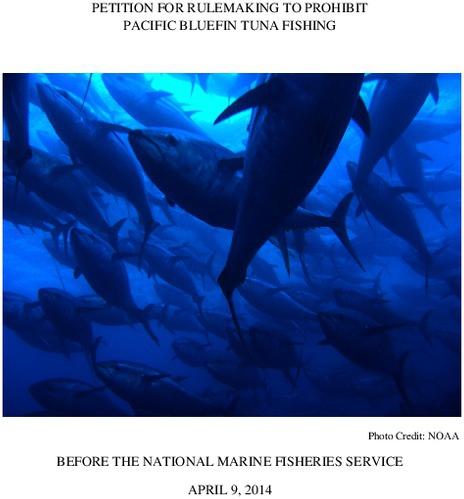From the Open-Publishing Calendar
From the Open-Publishing Newswire
Indybay Feature
Legal Petition Seeks Ban on Pacific Bluefin Tuna Fishing
SAN FRANCISCO— The Center for Biological Diversity today filed a legal petition (see PDF) urging the National Marine Fisheries Service to prohibit fishing for Pacific bluefin tuna, which has suffered a 96 percent decline since large-scale fishing began. News of the population’s historic low triggered a requirement for the Pacific Fishery Management Council to recommend new regulations for managing Pacific bluefin tuna by Tuesday, April 8. The council, though, declined to take any action to help bluefin.
“Despite the bluefin tuna’s great speed and deep-diving, it can’t escape the world’s insatiable appetite for sushi,” said Center Attorney Catherine Kilduff. “Saving Pacific bluefin tuna requires drastic action at all levels, starting by protecting them in the feeding grounds off California and Mexico.”
Today’s petition calls for the Fisheries Service to add Pacific bluefin tuna to a list of imperiled species that must be released immediately if caught, including great white sharks and other fish vulnerable to steep declines from fishing. While the U.S. sport fishery still catches bluefin tuna, often by traveling to Mexico’s waters, the once vibrant U.S. commercial fishery for Pacific bluefin tuna is a relic, with only sporadic catches in recent decades. Most of the bluefin tuna caught along the West Coast are juveniles.
“The days of seeing 9-foot bluefin tuna in the Pacific are sadly few and far between. U.S. fishery managers shouldn’t sit idly by while some of our ocean’s most magnificent fish get picked off before adulthood,” says Kilduff. “Failing to take every action possible to prevent the extinction of Pacific bluefin tuna would be a tragic mistake.”
Pacific bluefin tuna spawn in the western Pacific, near Japan, and some migrate to the California current as juveniles to feed on anchovy, herring and red crab. Once in the eastern Pacific Ocean, the bluefin tuna stay for a few years before going back to spawn off Japan’s waters. It is unknown what percent of the population makes the migration across the ocean to the U.S. West Coast as juveniles or returns after spawning as large, mature adults.
The largest recent reported catch of giant bluefin tuna in the eastern Pacific was made in 1988, when commercial nets caught an estimated 987 adult bluefin tuna off Southern California, including one that broke California records at more than 1,000 pounds and nearly 9 feet in length. Ninety percent of the worldwide catch of Pacific bluefin tuna now is less than 2 years old and under 3 feet long.
To join the Bluefin Boycott to reduce consumer demand for sushi, please go to http://www.bluefinboycott.org.
The Center for Biological Diversity is a national, nonprofit conservation organization with more than 675,000 members and online activists dedicated to the protection of endangered species and wild places.
April 9, 2014
http://www.biologicaldiversity.org/news/press_releases/2014/pacific-bluefin-tuna-04-09-2014.html
http://www.biologicaldiversity.org/
Today’s petition calls for the Fisheries Service to add Pacific bluefin tuna to a list of imperiled species that must be released immediately if caught, including great white sharks and other fish vulnerable to steep declines from fishing. While the U.S. sport fishery still catches bluefin tuna, often by traveling to Mexico’s waters, the once vibrant U.S. commercial fishery for Pacific bluefin tuna is a relic, with only sporadic catches in recent decades. Most of the bluefin tuna caught along the West Coast are juveniles.
“The days of seeing 9-foot bluefin tuna in the Pacific are sadly few and far between. U.S. fishery managers shouldn’t sit idly by while some of our ocean’s most magnificent fish get picked off before adulthood,” says Kilduff. “Failing to take every action possible to prevent the extinction of Pacific bluefin tuna would be a tragic mistake.”
Pacific bluefin tuna spawn in the western Pacific, near Japan, and some migrate to the California current as juveniles to feed on anchovy, herring and red crab. Once in the eastern Pacific Ocean, the bluefin tuna stay for a few years before going back to spawn off Japan’s waters. It is unknown what percent of the population makes the migration across the ocean to the U.S. West Coast as juveniles or returns after spawning as large, mature adults.
The largest recent reported catch of giant bluefin tuna in the eastern Pacific was made in 1988, when commercial nets caught an estimated 987 adult bluefin tuna off Southern California, including one that broke California records at more than 1,000 pounds and nearly 9 feet in length. Ninety percent of the worldwide catch of Pacific bluefin tuna now is less than 2 years old and under 3 feet long.
To join the Bluefin Boycott to reduce consumer demand for sushi, please go to http://www.bluefinboycott.org.
The Center for Biological Diversity is a national, nonprofit conservation organization with more than 675,000 members and online activists dedicated to the protection of endangered species and wild places.
April 9, 2014
http://www.biologicaldiversity.org/news/press_releases/2014/pacific-bluefin-tuna-04-09-2014.html
http://www.biologicaldiversity.org/
We are 100% volunteer and depend on your participation to sustain our efforts!
Get Involved
If you'd like to help with maintaining or developing the website, contact us.
Publish
Publish your stories and upcoming events on Indybay.
Topics
More
Search Indybay's Archives
Advanced Search
►
▼
IMC Network



